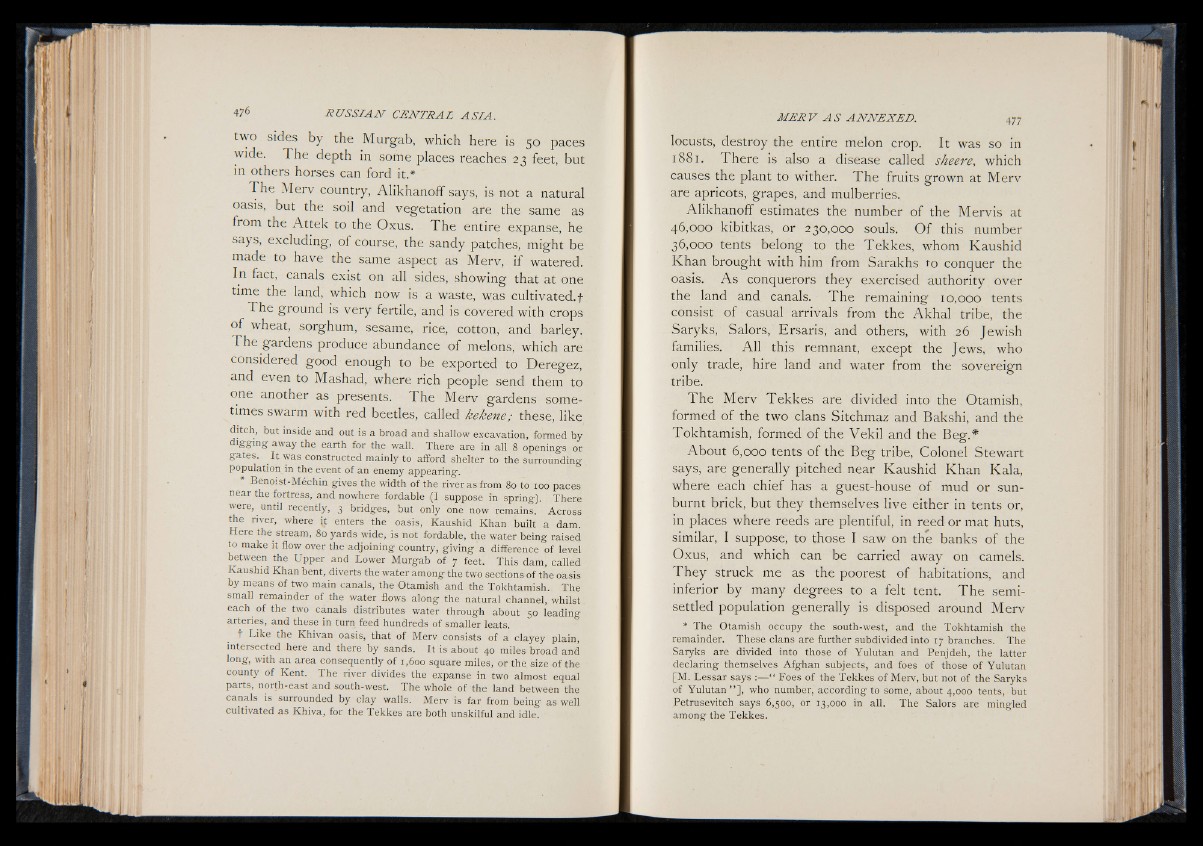
two sides by the Murgab, which here is 50 paces
wide. The depth in some places reaches 23 feet, but
in others horses can ford it.*
The Merv country, Alikhanoff says, is not a natural
oasis, but the soil and vegetation are the same as
from the Attek to the Oxus. The entire expanse, he
says, excluding, of course, the sandy patches, might be
made to have the same aspect as Merv, if watered.
In fact, canals exist on all sides, showing that at one
time the. land, which now is a waste, was cultivated, f
The ground is very fertile, and is covered with crops
of wheat, sorghum, sesame, rice, cotton, and barley.
The gardens produce abundance of melons, which are
considered good enough to be exported to Deregez,
and even to Mashad, where rich people send them to
one another as presents. The Merv gardens sometimes
swarm with red beetles, called kekene; these, like
ditch, but inside and out is a broad and shallow excavation, formed by-
digging away the earth for the wall. There are in all 8 openings or
gates. It was constructed mainly to afford shelter to the surrounding
population in the event of an enemy appearing.
* Benoist-Mechin gives the width of the river as from 80 to 100 paces
near the fortress, and nowhere fordable (I suppose in spring). There
were, until recently, 3 bridges, but only one now remains. Across
the river, where it enters the oasis, Kaushid Khan built a dam.
Here the stream, 80 yards wide, is not fordable, the water being raised
to make it flow over the adjoining country, giving a difference of level
between the Upper and Lower Murgab of 7 feet. This dam, called
Kaushid Khan bent, diverts the water among the two sections of the oasis
by means of two main canals, the Otamish and the Tokhtamish. The
small remainder of the water flows along the natural channel, whilst
each of the two canals distributes water through about 50 leading
arteries, and these in turn feed hundreds of smaller leats.
t Like the Khivan oasis, that of Merv consists of a clayey plain,
intersected here and there by sands. It is about 40 miles broad and
long, with an area consequently of 1,600 square miles, or the size of the
county of Kent. The river divides the expanse in two almost equal
parts, north-east and south-west. The whole of the land between the
canals is surrounded by clay walls. Merv is far from being as well
cultivated as Khiva, for the Tekkes are both unskilful and idle.
locusts, destroy the entire melon crop. It was so in
1881. There is also a disease called sheere, which
causes the plant to wither. The fruits grown at Merv
are apricots, grapes, and mulberries.
Alikhanoff estimates the number of the Mervis at
46.000 kibitkas, or 230,000 souls. O f this number
36.000 tents belong to the Tekkes, whom Kaushid
Khan brought with him from Sarakhs to conquer the
oasis. A s conquerors they exercised authority over
the land and canals. The remaining 10,000 tents
consist of casual arrivals from the Akhal tribe, the
Saryks, Salors, Ersaris, and others, with 26 Jewish
families. All this remnant, except the Jews, who
only trade, hire land and water from the sovereign
tribe.
The Merv Tekkes are divided into the Otamish,
formed of the two clans Sitchmaz and Bakshi, and the
Tokhtamish, formed of the Vekil and the Beg.*
About 6,000 tents of the Beg tribe, Colonel Stewart
says, are generally pitched near Kaushid Khan Kala,
where each chief has a guest-house of mud or sunburnt
brick, but they themselves live either in tents or,
in places where reeds are plentiful, in reed or mat huts,
similar, I suppose, to those I saw on thé banks of the
Oxus, and which can be carried away on camels.
They struck me as the poorest of habitations, and
inferior by many degrees to a felt tent. The semisettled
population generally is disposed around Merv
* The Otamish occupy the south-west, and the Tokhtamish the
remainder. These clans are further subdivided into 17 branches. The
Saryks are divided into those of Yulutan and Penjdeh, the latter
declaring themselves Afghan subjects, and foes of those of Yulutan
[M. Lessar says :— “ Foes of the Tekkes of Merv, but not of the Saryks
of Yulutan” ], who number, according to some, about 4,000 tents, but
Petrusevitch says 6,500, or 13,000 in all. The Salors are mingled
among the Tekkes.